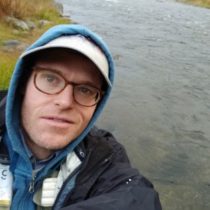Success Stories and Ongoing Efforts
- This topic has 15 replies, 9 voices, and was last updated 3:58 PM on 2019-07-25 by Kim Hachadoorian.
-
AuthorPosts
-
2018-12-11 at 3:20 PM #153138
 David BresslerParticipant
David BresslerParticipantPurpose: success stories and ongoing efforts in monitoring, education, and outreach in the context of EnviroDIY sensor stations.
2018-12-17 at 3:54 PM #153146 Matt GisondiParticipant
Matt GisondiParticipantShowcasing two awesome volunteers that came out on a recent, rainy Sunday to gather data for their sites. Meet Chris Marshall and Jen Harris from the First State National Historic Park cluster! Thank you Chris and Jen for coming out to mucky conditions and being attentive while I walked you guys through the process of field data collecting. Special thanks to Jen’s driving skills and Chris’s guidance while we searched for a newer, safer entrance to a hard-to-get station. Through their teamwork, they got us out of situation of my own making, travelling down a thin, rocky road with trenches on one side and boulders on the other. Not a scratch!
2018-12-20 at 10:53 AM #153150Kim Hachadoorian
ParticipantAwesome work, Matt, Jen and Chris!
2019-01-03 at 9:16 AM #153167Kristine Rogers
ParticipantHappy New Year everyone! I’m reaching out to let you know about an exciting update with our Paulins Kill monitoring sensor at Sussex County Community College in Newton, NJ. Since the sensor was installed in October 2017, I’ve been working with a new group of environmental science college students each semester and have trained them how to conduct maintenance on our sensor station. One of the most frustrating aspects of this set-up was the fact that by the time a great group of students was trained, they would be done with their environmental science course and no longer interested in continuing to maintain the sensor. However, I’m very happy to report that this summer I met a student at the community college who is really passionate about tracking the water quality on the campus. He was very upset to see that during the summer there were dead fish floating in the large pond on campus.
Recognizing that there was a water quality issue, he contacted the community college president to voice his concerns and was told to reach out to me. Together, we developed a stream monitoring program for the campus. Since then, he has formed a club known as the Skylands Environmental Analysts that has been conducting weekly water quality samples during the semester at 6 different locations on campus, including near the Delaware Basin sensor station. He has also been recruiting other students to become involved in this effort so hopefully the enthusiasm will only continue to grow throughout 2019!
I wish you all the best for your own successful monitoring,
Kristine2019-01-14 at 12:16 PM #153240 David BresslerParticipant
David BresslerParticipantFYI, EPA webpage with examples of success stories: Success Stories about Restoring Water Bodies Impaired by Nonpoint Source Pollution
2019-01-30 at 11:28 AM #153271Carol Armstrong
ParticipantSometimes there are smells that are not normal for a stream and can indicate a problem that should be investigated. I’ve smelled animal/human waste smells while cleaning the sensors and taking measurements. In one of these cases, I walked up wind to investigate a source, and found two damaged risers with manhole covers that were streamside and upstream from the sensors in an old suburban Philadelphia neighborhood. Looking closer, I saw white particles and scum of some type around the sensors, and saw that the particles were also found upstream from the sensors. This was a health problem and a data contamination problem. I reported it first to the county Conservation District, who directed me to PA DEP’s Clean Water Program. They responded very quickly, and after sending pictures and providing more info and location, the PA DEP investigated the site and reported the violation to the township. The PA DEP reported that the township fixed the problem. The PA DEP has a reporting line for environmental complaints, and water quality problems should be reported immediately by calling or leaving a message: 484-250-5991. There is an emergency line for problems such as spills and fish kills: 484-250-5900 which operates 24/7/365 (statewide line: 866-255-5158).
2019-01-31 at 8:58 AM #153273Sarah Ferrell
ParticipantHi everyone! Sharing an article that was recently posted on The Independence School’s website about how our middle school students are benefiting from water quality monitoring and usage of the sensor stations on campus. Enjoy!
2019-02-27 at 11:48 AM #153324 David BresslerParticipant
David BresslerParticipantA reminder to please post updates on Success Stories – just a simple description would be very much appreciated.
These stories don’t have to be complete, so please post updates on any number of topics such as flooding/flashy flows, road salts, sediment issues, volunteer recruitment/involvement, education, etc.
2019-02-27 at 7:01 PM #153327Dave Yake
ParticipantHello folks, I wanted to give you a quick update on some novel ways to characterize your watershed Total Suspended Solids vs. runoff rain events. I have done some work on watersheds ranging from 0.73 sq. mi. to over 8 sq. mi. One can use this correlation to essentially “fingerprint” the erosion of your watershed vs. storm event intensity (ie… runoff intensity and total surface runoff).
For each rain event you can determine the “slope” of the rising RunOff hydrographic (flow vs. time… also called RunOff Intensity) and estimate the amount of surface runoff for the rain event from the runoff curve. Then you can plot Total Sediment/ rain event on the “y” axis and the product of “RunOff Intensity (cfs/hr/sq. mi. of watershed)* Surface RunOff”(in. of rain) on the “X” axis.
We have gotten nice straight lines with very high precision (98%+)
We have also had some success in plotting Sediment loading for each rain event vs.Peak RunOff and Peak RunOff **2
The nice aspect of this correlation is that IF you are interested detecting changes in the watershed erosion characteristics, either good due to your work… or bad due to new development (which increases the RunOff Intensity and Surface RunOff). In this respect, if RunOff intensity (peak flow) and surface runOff are higher, then erosion will be higher.
If you are seeing continued development w/in the watershed, then you can use Wikiwatershed to characterize the runoff characteristics to see how increased development can change runoff…. and then you can estimate the sediment loading impact from the relationship of RunOff Intensity*RunOff.
If you are interested in learning more about this or having me help you do an assessment of your watershed, please let me know.
Dave Yake
Attachments:
2019-03-01 at 2:52 PM #153331 David BresslerParticipant
David BresslerParticipantDave Yake,
For some of the March 13 workshop at Stroud we’re going to have multiple groups led by different Stroud folks. Shannon and I will be working with you and Marion Waggoner and some others. We should plan to discuss this. I think the main thing we should do is more clearly define what this tool does, when it can be used, and in what specific current situations it could be used.
-
AuthorPosts
- You must be logged in to reply to this topic.
